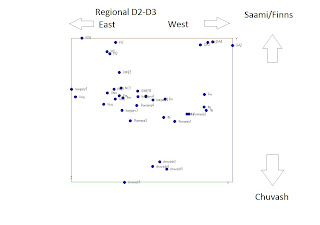There exists some similarity between Finns and Lithuanians not seen in Saamis, so when adding the Lithuanians the Finns moved out of the North-Saami cluster compared to the previous analysis. Therefore Lithuanians where added. Also FI5 and FI6 where 2nd cousins pulled down the Finns into the North-Saami cluster. Removing each indepentently resulted in the same effect suggesting the relatedness had an effect in the analysis. FI6 was therefore removed.
The MDS plots can be confusing for some. I therefore made a map showing the geographic average distributions for the 3 main components and it may show an intriging history. Dimension 1 accounts for the most of the variation, while dimension 2 account for the second largest genetic variantion while dimension 3 account for the third largest genetic variation. Therefore the dimensions do not acount equally when represented in a 3D view.
The map appears to show Saamis as extremes in all three dimensions.
This is how much each dimension explains the genetic variation in each dimension:
D1: 20 604 SNP 4.2%
D2: 10 417 SNP 2.1%
D3: 8 560 SNP 1.8%
Dimension Total: 8.1%
This is how much each dimension explains the genetic variation in each dimension:
D1: 20 604 SNP 4.2%
D2: 10 417 SNP 2.1%
D3: 8 560 SNP 1.8%
Dimension Total: 8.1%
D1: Saamis, Finns and Vologda Russians appears to make a far eastern bridge. Earlier analysis seem to suggest that this is a Siberian component seen in Europe. It appears absolutely lowest among the Italians. Note that the Italians appears to be "isolated" in Europe in this context with much higher rates seen in close populations. Scandinavians appear closest to Belorussians and Hungarians in this dimension.
D2 also appears very high among the Saami and seem to have a western European distribution as it has high frequency also among Finns, Swedes and Norwegians. It is also higher in western Europe as seen among the French and Italians. However it drops very dramatically from Finns to Lithuanians, Estonia and Vologda Russian. The level increases again in more western east-European populations like Hungarians and Romanians.
D3 also appears very high among the Saami but shows an intriguing pattern. Its very low among Scandinavians, Lithuanians and Estonians, however the next highest occurrences are found among the Italians, then the Romanians and the Vologda Russians and then finally Finns just somewhat above intermediate levels like the French, Hungarians and Belorussians.
May it be the "eastern component" researcher Tambets mentions in her abstract for the coming paper about genetic of the uralic speakers? If yes why is it also found second highest among Italians?
Also the local opposite clustering of this component only seen among Norwegians, Swedes, Lithuanians and Estonians are intriguing suggesting something in common.
As the result indicate the Saami outlierness appears to be the sum of these 3 different dimensions or genetic components. Italians appears to be opposite outlier in D1, Lithuanians appears to be opposite outlier in D2 and Swedes appears to be opposite outlier in D3.













